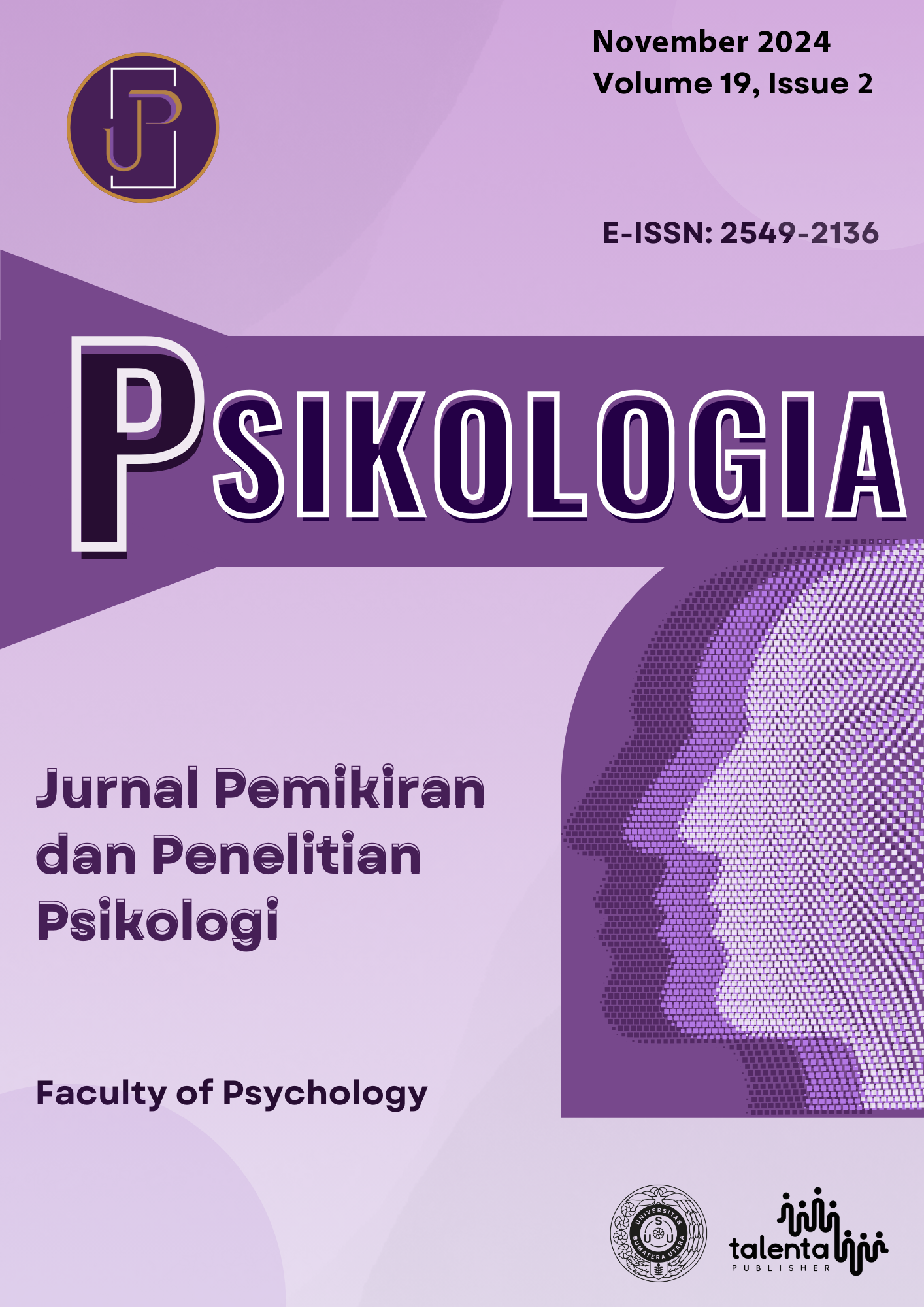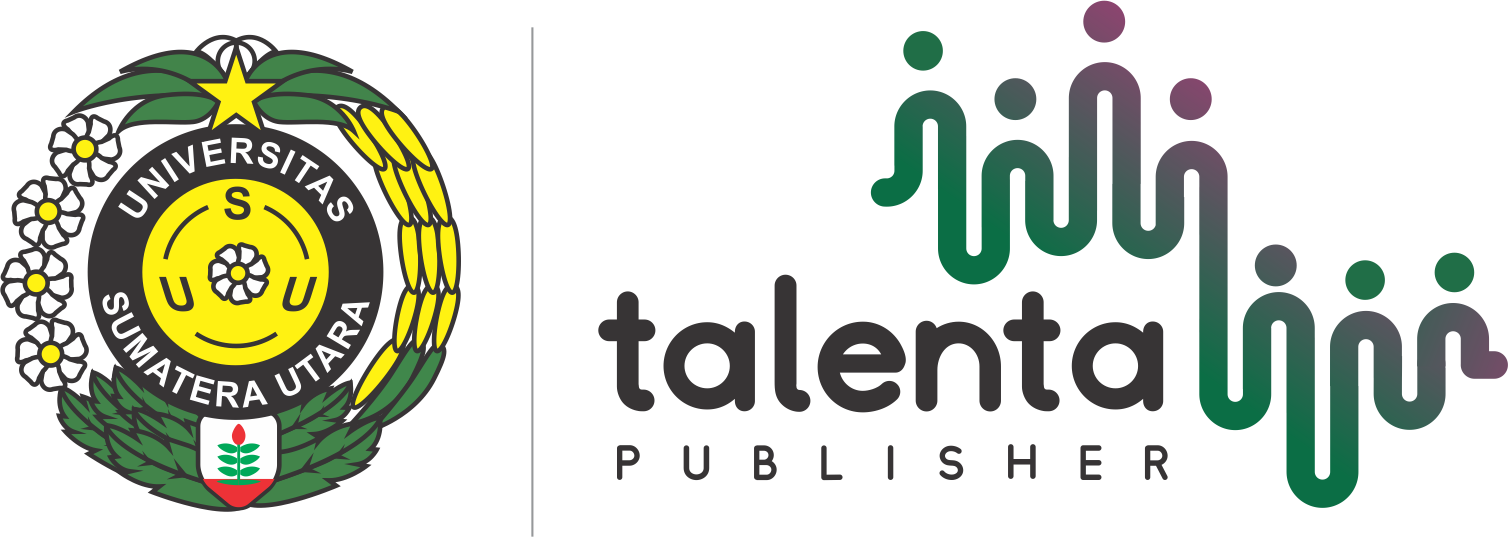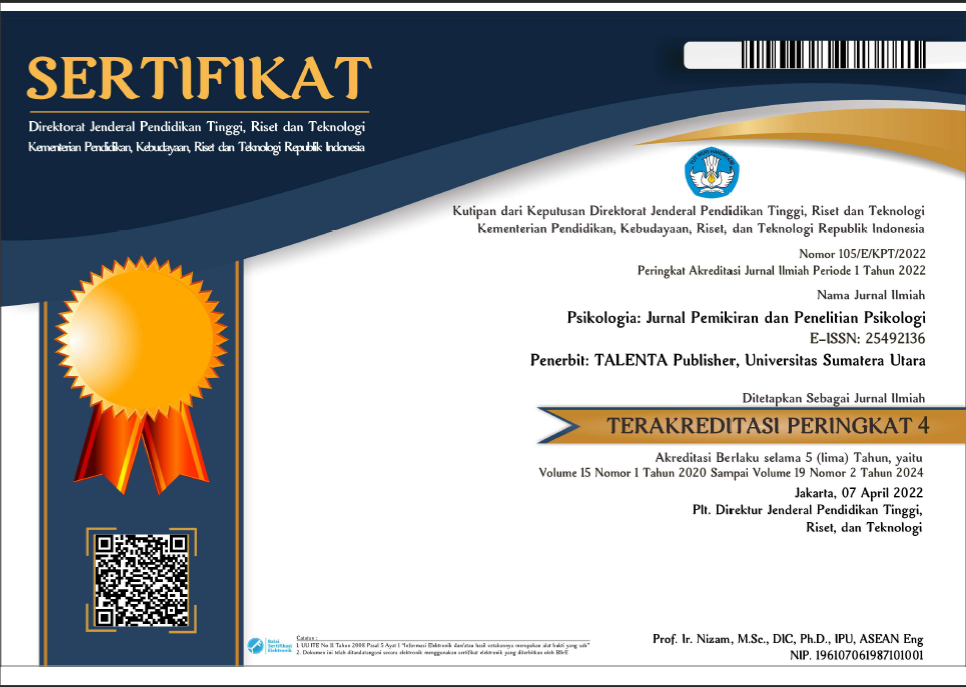Work-family conflict and job stress as predictors of quality of work-life among nurses
DOI:
https://doi.org/10.32734/psikologia.v19i2.17668Keywords:
job stress, quality of work life, work-family conflict, nursesAbstract
This study investigated predictors of quality of work life among nurses in Ipokia Local Government Area in Ogun State, Nigeria. A cross-sectional survey design was adopted to collect data using the Quality of Life Scale, Work-Family Conflict Scale, and Job Stress Scale. A purposive sampling technique was used to select 182 nurses (Females: 123; Males: 59). Data were analyzed using multiple regression analysis, t-test of independent mean, and one-way analysis of variance. Three hypotheses were generated and tested at a 0.001 level of significance. The result revealed that work-family conflict and job stress jointly predicted the quality of work-life among nurses [R2 = 286, F (2,181) = 37.648, p = .002). Also, job stress independently predicted the quality of work-life among nurses (β = .543, p = .001). However, work-family conflict did not independently predict the quality of work-life among nurses (β =-.001, p >.05). It was concluded that work-family conflict was a significant factor when combined with job stress but not an independent predictor of quality of work-life among nurses. Therefore, the Chief Medical Director and Human Resource Department of hospitals should monitor the stress levels of their nurses to ensure continuous productivity and avoid unnecessary breakdown of nurses at Work and home.
Downloads
References
Abechi, A.A., &Egbuche, N.M. (2018). Effects of work-family conflict among female nurses in Abuja Municipal Area. Lapai International Journal of Administration, 1(1), 1-35 https://www.lija.com
Adibe, M.O., Ubaka, C.M., Ddeogaranya, P.O., Igbeli. N. U., &Igwe, K.A.A. (2014). Effect of occupational factors on the quality of life of workers in governmental and non-governmental sectors in Southeastern Nigeria. Tropical Journal of Pharmaceutical Research, 13(2), 287-293. https://doi.org/10.4314/tjpr.v13i2.19
Adikoeswanto, D., Eliyana, A, Hamidah, H., Sariwulan, T., Buchdad, A. D, &Firda, F.(2020). Quality of work life’s factors and their impacts on organizational commitments. Systematic Reviews in Pharmacy, 11 (7), 450-461 https://doi.org/10.31838/srp.2020.65
Agarwal, S. (2020). Gender differences in quality of work-life: An empirical study. International Journal of Knowledge-Based Organizations, 10 (4), 52-59 https://doi.org/10.4018/IJKBO.2020100105
Ahmed, G., AbdElazeem, S. & Abdallah, H. (2020). The relationship between quality of work-life and occupational stress among head nurses in Port Said hospitals. Port Said Scientific Journal of Nursing, 7(2), 147-160 https://doi.org/10.21608/pssjn.2020.99593
Alserhan, H., Al-Adamat, A., & Al-Adamat, O. (2021). The mediating effect of employee happiness on the relationship between quality of work-life and employee intention to quit: A study on fast-food restaurants in Jordan. Management Science Letters, 11(3), 933-938. www.gs.com
Argentero, P., Miglioretti, M., &Angilletta, C. (2007). Quality of work-life in a cohort of Italian health workers. G Ital Med Lav Ergonomics, 29(1), A50-A54 www.nlm.com
Bolhari, A., Rezaeean, A., Bolhari, J., Bairamzadeh, S., &Soltan, A. A. (2011). The relationship between quality of work-life and demographic characteristics of information technology staffs. International Conference on Computer Communication and Management (CSIT. Singapore: IACSIT Press www.ipcsit.com
Brooks, B.A. & Anderson, M.A. (2005). Defining quality of life nursing work-life. Nursing Economics, 23 (6), 319-379 www.ne.com
Carlson, D. S., &Kacmar, K. M. (2000). Work-family conflict in the organization: Do life role values make a difference? Journal of Management, 26(5), 1031-1054. https://doi.org/10.1177/014920630002600502
Elisha, J.M. (2023). Impact of psychological contract breach and abusive supervision on turnover intention among some selected health workers in Nigeria. BSc thesis submitted to the Department of Pure and Applied Psychology, Adekunle Ajasin University, Akungba-Akoko, Ondo State, Nigeria. Pp i+vi, 1-64.
Hingly, P. (1984). The humane face of nursing. Nursing Mirror, 159(21), 19-22. www.nm.com
Hyun, S., Lee, S., & Moon, G. (2016). A study on the effect of the work-family mediated moderation model of emotional exhaustion and positive psychology capital. World Academy of Science, Engineering, & Technology, International Journal of Humanities & Social Sciences, 3(2), 85-87 www.waset.com
Ilo, C.I., Agbapuonwu, N., Makata, N. E., &Anieche, J.E.(2020). Nursing and midwifery job characteristics and influence on work-family conflict among nurses working in teaching hospitals in Anambra State, Nigeria. International Journal of Nursing & Midwifery, 12(3), 97-104 https://doi.org/10.5897/IJNM2019.0393
Indumathi, G. S., & Selvan, R.T. (2018). A perception of quality of work-life among male and female employees in the information technology companies. International Journal of Research in Engineering & Technology, 1 (7), 31-36 www.ijret.com
Lad, N. N. (2016). Influence of gender and working area on quality of work-life and mental health among employees. The International Journal of Indian Psychology, 3 (3), 74-82. https://doi.org/10.18.01.142/20160303
Lazarus, R.S. & Folkman, S. (1984). Stress, appraisal, and coping. Springer.
Leitao, J., Pereira, D., & Goncalves, A. (2019). Quality of work life and organizational performance: Workers' feeling of contributing, or not, to the organization's productivity. International Journal of Environmental and Public Health,16, 1-18. https://doi.org/10.3390/ijerph16203803
Mamman, J.C. & Savitha, K.V. (2019). Marital adjustment and quality of work-life among nurses. International Journal of Advanced Scientific Research & Management, 4(5), 297- 301 www.ijasrm.com
Monroe, M., Morse, E., & Price, J.M. (2020). The relationship between critical care work environment and professional quality of life. American Journal of Critical Care, 29(2), 145-149 https://doi.org/10.4037/ajcc2020406
Odebiyi, I.I. (2021). Effect of human resource management practices on turnover intentions among medical practitioners. Journal of Business & Organizational Development, 13(1), 1-18
Okafor, C. A. (2020). Work-life conflict and performance of female health professionals in federal teaching hospitals in the Southeast, Nigeria. International Journal of Innovative Social Sciences & Humanities Research, 8(3) 114-126 www.ijisshr.com
Osibanjo, O., Adeniji, A., Odunayo, S.,Falola, H., Atolagbe, T., & Ojebola, O. (2020). A systematic review of organizational citizenship behavior and its influence on employee turnover intentions in Nigeria's healthcare sector. Proceedings of INTCESS 2020- 7th International Conference on Education and Social Sciences, 20-22 January 2020 - DUBAI (UAE), 1319-1327.
Pandu, A. (2019). Work-family conflict and family-work conflict and their effects on quality of life among leather industry workers. International Journal of Recent Technology and Engineering, 8(4), 1-9 https://doi.org/10.35940/ijrte.D7978.118419
Pavlonic, J., Racic, M., Radovic, N, Jokovic, S, &Hadzivukovic, N. (2017). Work-related stressors and quality of life of nurses. In book: Health of the working–Age Population, pp, 149-154
Rashidi, Z., &Jalbani, A. A. (2009). Job stress among software professionals in Pakistan: A Factor analytic study. Journal of Independent Studies & Research, 7, 1-12 www.jisr.szabist.edu.pk
Saputera, B. &Suhermin, S. (2020) Understanding nurse workload, work stress, and supervision on the influence of clinical performance. Proceeding of 1st International Conference on Business & Social Sciences, 155-167 https://ojsicobuss.stiesia.ac.id/index.php/icobuss1st/article/view/18
Scharbroeck, J. & Cooper, C. L. (2000). The changing nature of work and stress. Journal of Managerial Psychology, 15, 227-241 https://doi.org/10.1108/02683940010320589
Smiley, R.A., Ruttinger, C., Oliveira, C. M., Hudson, L.R.,Allgeyer, R., Reneau, K.A., Silvestre, J.H., & Alexander, M.(2021). The 2020 national nursing workforce survey. Journal of Nursing Regulation, 12 (Supplement), S1-S96 https://doi.org/10.1016/S2155-8256(21)00027-2
Snow, C. C., Hult, G. T. M., &Kandemir, D. (2003). The role of entrepreneurship in building cultural competitiveness in different organizational types. Journal of Management, 29 (3), 401-426 https://doi.org/10.1016/S0149-2063_03_00017-5
Suleiman, K., Hijazi, Z., Kalaldeh, M., Al, & Sharour, L.A. (2019). Quality of nursing work life and related factors among emergency nurses in Jordan. Journal of Occupational Health,61(5), 398-406 https://doi.org/10.1002/1348-9585.12068
Syahrul, S., Suaib, A., & Tahir, T. (2019). Nurses’ quality of work life. Journal of Health Science & Prevention, 3 (3), 63-66 https://doi.org/10.29080/jhsp.v3i3S.292
Tabassum, A., Rahman, T., & Jahan, K. U. R. S. I. A. (2011). Quality of work-life among male and female employees of private commercial banks in Bangladesh. International Journal of Economics &Management, 5(1), 266-282 www.ijem.upm.edu.my
Tai, S., Yu, Lin, P.C., Chen, Y. M., Hung, H.C., Pan, C. H., Pan, S.M., Lee, C. Y., Huang, C.T., & Wu, M. T. (2014). Effects of marital status and shift work on family function among registered nurses. Industrial Health, 52(4), 296-303 https://doi.org/10.2486/inhealth.2014-0009
The Marlin Company and the American Institute of Stress (1999). The Workplace Stress Scale. Yonkers, NY. Accessed on: 02/07/2022, Available at: http:// www.executivestresscoach.com/JOBSTRESS.htm
Ugwu, C.C. (2022).Work and family role conflict and work engagement among nurses: The moderating role of resilience. International Journal of Management, Social Sciences, Peace & Conflict Studies, 5(1), 229-243 https://ijmsspcs.com
Uysal, M., &Sirgy, M. J. (2019). Quality of life indicators as performance measures. Annals of Tourism Research, 76, 291-300 https://doi.org/10.1016/j.annals.2018.12.016
Van Laar, D., Edwards, J. A., & Easton, S. (2007). The workâ€related quality of life scale for healthcare workers. Journal of Advanced Nursing, 60(3), 325-333 https://doi.org/10.1111/j.1365-2648.2007.04409.x
Downloads
Published
How to Cite
Issue
Section
License
Copyright (c) 2024 Enyelunekpo R. Roberts, Michael A. Oladep, Peter O. Olapegba , & Emmanuel E. Uye

This work is licensed under a Creative Commons Attribution-ShareAlike 4.0 International License.









